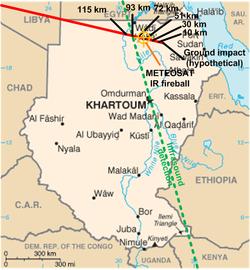2008 TC3


2008 TC3 (Catalina Sky Survey temporary designation 8TA9D69) was a meteoroid 2 to 5 meters (7 to 16 ft) in diameter that entered Earth's atmosphere on October 7, 2008 at 02:46 UTC (5:46 a.m. local time) and burned up before making physical contact with the ground. [1]
Discovery
The meteoroid was discovered by an observer at the Catalina Sky Survey (CSS) 1.5 meter telescope at Mount Lemmon, north of Tucson, Arizona, USA about a day before the impact.[2][3]
The meteoroid was notable as the first such body to be observed and tracked prior to reaching Earth.[4] The process of detecting and tracking a near-Earth object, an effort sometimes referred to as Spaceguard, was put to a test. In total, 570 astrometric and almost as many photometric observations were performed in less than 19 hours and reported to the Minor Planet Center, which issued 25 Minor Planet Electronic Circulars with new orbit solutions in eleven hours as observations poured in. Impact predictions were performed by University of Pisa's CLOMON 2 semi-automatic monitoring system[5][6] as well as Jet Propulsion Laboratory's Sentry system. Spectral observations were performed by astronomers at the 4.2 meter William Herschel Telescope at La Palma, Canary Islands.
Explosion
The meteoroid, also considered a bolide[7] due to its fiery explosion, is confirmed to have entered Earth's atmosphere above northern Sudan at a velocity of 12.8 kilometres per second (8.0 mi/s). Estimated trajectory has the object coming out of the western sky at an azimuth of 281 degrees, and an altitude angle of 19 degrees to the local horizon.

It exploded tens of kilometers above the ground with the energy of around one kiloton of TNT, causing a large fireball in the early morning sky.[8] Very few people inhabit the remote area of the Nubian Desert where the explosion took place; The Times, however, reported that the meteoroid's "light was so intense that it lit up the sky like a full moon and an airliner 1,400 km (870 miles) away reported seeing the bright flash."[9] A low-resolution image of the explosion was captured by the weather satellite Meteosat 8.[10] Infrasound detector arrays in Kenya also detected a sound wave from the direction of the expected impact corresponding to energy of 1.1 to 2.1 kilotons of TNT.[11] Meteoroids of this size hit Earth about two or three times a year.[12]
The trajectory showed intersection with Earth's surface at roughly 20.3° north, 33.5° east,[13] though the object was expected to break up perhaps 100–200 kilometers west as it descended, somewhat east of the Nile River, and about 100 kilometers south of the Egypt–Sudan border.
References
- ^ Plait, Phil (2008-10-06). "Incoming!!!". Bad Astronomy. Retrieved 2008-10-08.
- ^ Williams, Gareth V. (2008-10-06). "MPEC 2008-T50". Minor Planet Center. Retrieved 2008-10-08.
- ^ Huntington, Jenny (2008-10-07). "Small Asteroid Enters Earth's Atmosphere". eFluxMedia. Retrieved 2008-10-08.
- ^ Roylance, Frank (2008-10-07). "Predicted meteor may have been sighted". MarylandWeather. Retrieved 2008-10-08.
- ^ "NEODys Main Risk Page". Retrieved 2008-10-08.
- ^ "NEODys 2008 TC3 page". Retrieved 2008-10-08.
- ^ "Astronomers predict shooting star over Sudan from space boulder". AFP. Retrieved 2008-10-08.
- ^ "Asteroid hits Earth... Good news: Scientists predicted it. Bad News: Only six hours before it burst into our atmosphere". dailymail.co.uk. 2008-10-07. Retrieved 2008-10-08.
- ^ Simon, Paul (2008-10-08). "Weather Eye: NASA spots asteroid before annihilation". timesonline.co.uk. Retrieved 2008-10-08.
- ^ "ASTEROID IMPACT". SpaceWeather.com. 2008-10-08. Retrieved 2008-10-08.
- ^ "Impact of Asteroid 2008 TC3 Confirmed". NASA Near Earth Object Program. 2008-10-07. Retrieved 2008-10-08.
- ^ Borenstein, Seth (2008-10-06). "Small asteroid headed for light show over Africa". Yahoo! News. Retrieved 2008-10-08.
- ^ "Mike" (2008-10-06). "Very near NEO Meteoroid impact!". MKVH.de.
External links
| External image | |
|---|---|
- Remanzacco Observatory photographs of the incoming space rock
- Animation of impact from the asteroid's point of view (Pasquale Tricarico of the Planetary Science Institute)
- News bulletin from NASA Near Earth Object Program
- Impact Trajectory on October 7, 2008
- Circled, the object caught on camera as it sped towards Earth
- The full story of Earth-impacting asteroid 2008 TC3 by Emily Lakdawalla (The Planetary Society Blog)
- 2008 TC3: A Serendipitous Event by Tavi Greiner (The Slooh SkyLog)
